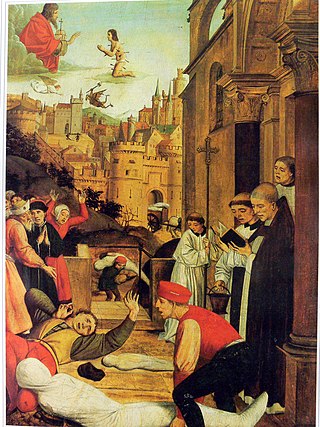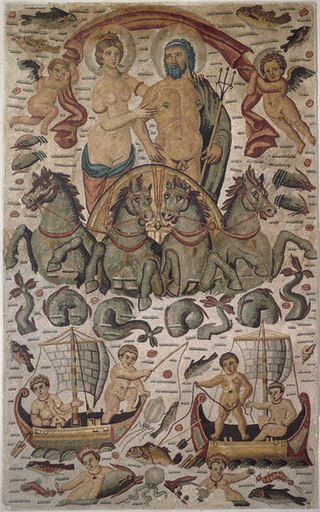
In Ancient Roman architecture, a basilica was a large public building with multiple functions that was typically built alongside the town's forum. The basilica was in the Latin West equivalent to a stoa in the Greek East. The building gave its name to the architectural form of the basilica.

Britannia is the national personification of Britain as a helmeted female warrior holding a trident and shield. An image first used by the Romans in classical antiquity, the Latin Britannia was the name variously applied to the British Isles, Great Britain, and the Roman province of Britain during the Roman Empire. Typically depicted reclining or seated with spear and shield since appearing thus on Roman coins of the 2nd century AD, the classical national allegory was revived in the early modern period. On coins of the pound sterling issued by Charles II of England, Scotland, and Ireland, Britannia appears with her shield bearing the Union Flag. To symbolise the Royal Navy's victories, Britannia's spear became the characteristic trident in 1797, and a helmet was added to the coinage in 1825.

The plague of Justinian or Justinianic plague was an epidemic that afflicted the entire Mediterranean Basin, Europe, and the Near East, severely affecting the Sasanian Empire and the Byzantine Empire and especially Constantinople. The plague is named for the Byzantine Emperor Justinian I who according to his court historian Procopius contracted the disease and recovered in 542, at the height of the epidemic which killed about a fifth of the population in the imperial capital. The contagion arrived in Roman Egypt in 541, spread around the Mediterranean Sea until 544, and persisted in Northern Europe and the Arabian Peninsula until 549. By 543,the plague had spread in every corner of the empire. As the first episode of the first plague pandemic it had profound economic, social, and political effects across Europe and the Near East and cultural and religious impact on Eastern Roman society.

Cirta, also known by various other names in antiquity, was the ancient Berber and Roman settlement which later became Constantine, Algeria.

The Mausoleum of Galla Placidia is a Late Antique Roman building in Ravenna, Italy, built between 425 and 450. It was added to the World Heritage List together with seven other structures in Ravenna in 1996. Despite its common name, the empress Galla Placidia was not buried in the building, a misconception dating from the thirteenth century; she died in Rome and was buried there, probably alongside Honorius in the Mausoleum of Honorius at Old Saint Peter's Basilica.

In botany, a cortex is an outer layer of a stem or root in a vascular plant, lying below the epidermis but outside of the vascular bundles. The cortex is composed mostly of large thin-walled parenchyma cells of the ground tissue system and shows little to no structural differentiation. The outer cortical cells often acquire irregularly thickened cell walls, and are called collenchyma cells.

Wytham is a village and civil parish on the Seacourt Stream, a branch of the River Thames, about 3 miles (5 km) northwest of the centre of Oxford. It is just west of the Western By-Pass Road, part of the Oxford Ring Road (A34). The nearest village is Godstow. Wytham was the northernmost part of Berkshire until the 1974 boundary changes transferred it to Oxfordshire. The toponym is first recorded as Wihtham around 957, and comes from the Old English for a homestead or village in a river-bend.

A flèche is the name given to spires in Gothic architecture. In French, the word is applied to any spire, but in English it has the technical meaning of a spirelet or spike on the rooftop of a building. In particular, the spirelets often built atop the crossings of major churches in mediaeval French Gothic architecture are called flèches.

Akhund is a Persian title or surname for Islamic scholars, common in Iran, Afghanistan, Tajikistan, Pakistan, Bangladesh, and Azerbaijan. Other names for similar Muslim Scholar include Sheikh and Mullah.

In ancient Rome, the ancilia were twelve sacred shields kept in the Temple of Mars. According to legend, one divine shield fell from heaven during the reign of Numa Pompilius, the second king of Rome. He ordered eleven copies made to confuse would-be thieves, since the original shield was regarded as one of the pignora imperii , sacred guarantors that perpetuated Rome as a sovereign entity.

Arcadia or Arcadia Aegypti was a Late Roman province in northern Egypt. It was named for one of the reigning Augusti of the Roman Empire, Arcadius of the Theodosian dynasty when it was created in the late 4th century. Its capital was Oxyrhynchus and its territory encompassed the Arsinoite nome and the "Heptanomia" region.

Dacia Ripensis was the name of a Roman province in the northern Balkan peninsula, immediately south of the Middle Danube. Its capital was Ratiaria. It was a district less urban than neighbouring Dacia Mediterranea and more militarized; "military camps and forts, rather than cities, were typical of the province". Besides Ratiaria, Oescus was the major settlement.

In the Roman Empire during Late Antiquity, the adventus was a ceremony held to celebrate the arrival at a city of a Roman emperor or other dignitaries. The imperial adventus was the period's "ceremonial par excellence", celebrating both the emperor's arrival and the blessing of the imperial presence itself on the city's security. The term is also used to refer to artistic depictions of such ceremonies.

Licinius II, also called Licinius Junior or Licinius Caesar, was the son of the Roman emperor Licinius I. He held the imperial rank of caesar between March 317 and September 324, while his father was augustus, and he was twice Roman consul. After losing a civil war, his father lost power and both he and Licinius the Younger were eventually put to death.

William de Ramsey was an English Gothic master mason and architect who worked on and likely designed the two earliest buildings of the Perpendicular style of Gothic architecture. William Ramsey was likely an inventor of the Perpendicular style which was to dominate Gothic architecture in England for three centuries "and, if so, he was one of the most influential architects England has ever produced".
The first plague pandemic was the first historically recorded Old World pandemic of plague, the contagious disease caused by the bacterium Yersinia pestis. Also called the early medieval pandemic, it began with the Plague of Justinian in 541 and continued until 750 or 767; at least fifteen or eighteen major waves of plague following the Justinianic plague have been identified from historical records. The pandemic affected the Mediterranean Basin most severely and most frequently, but also infected the Near East and Northern Europe, and potentially East Asia as well. The Roman emperor Justinian I's name is sometimes applied to the whole series of plague epidemics in late Antiquity.

A windjammer is a commercial sailing ship with multiple masts that may be square rigged, or fore-and-aft rigged, or a combination of the two. The informal term "windjammer" arose during the transition from the Age of Sail to the Age of Steam during the 19th century. The Oxford English Dictionary records the word "windjamming" from 1886 and "windjammer" with reference to a ship from 1892. The term has evolved to include such a vessel, carrying passengers on overnight cruises in the Caribbean, the U.S. state of Maine and elsewhere.

The Oxford Dictionary of Late Antiquity (ODLA) is the first comprehensive, multi-disciplinary reference work covering culture, history, religion, and life in Late Antiquity. This was the period in Europe, the Mediterranean, and the Near East from about AD 250 to 750. Written by more than 400 contributors and edited by Oliver Nicholson, the Oxford Dictionary of Late Antiquity was published in 2018. It connects the period in history between those covered in the Oxford Classical Dictionary and The Oxford Dictionary of the Middle Ages. The print edition is in two volumes, Volume I: A–I; Volume II: J–Z.

Perpendicular Gothic architecture was the third and final style of English Gothic architecture developed in the Kingdom of England during the Late Middle Ages, typified by large windows, four-centred arches, straight vertical and horizontal lines in the tracery, and regular arch-topped rectangular panelling. Perpendicular was the prevailing style of Late Gothic architecture in England from the 14th century to the 17th century. Perpendicular was unique to the country: no equivalent arose in Continental Europe or elsewhere in the British Isles. Of all the Gothic architectural styles, Perpendicular was the first to experience a second wave of popularity from the 18th century on in Gothic Revival architecture.
In ancient Rome there were a variety of officials tasked with banking. These were the argentarii, mensarii, coactores, and nummulari. The argentarii were money changers. The role of the mensarii was to help people through economic hardships, the coactores were hired to collect money and give it to their employer, and the nummulari minted and tested currency. They offered credit systems and loans. Between 260 and the fourth century CE Roman bankers disappear from the historical record, likely because of economic difficulties caused by the debasement of the currency.


















